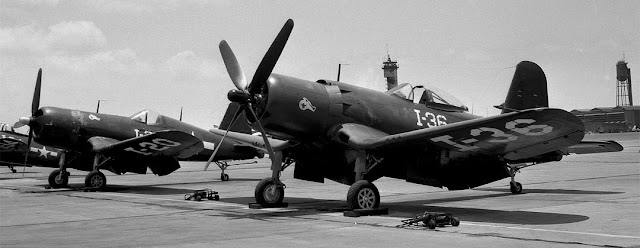The request was to identify the unit to which this SB2C-4E was assigned. The picture was reportedly taken after the war, possibly at NAS Atlantic City in 1947.
Warren Bodie photo, Thomas Doll collection via Angelo Romano
The camouflage and markings are unusual. First, it is one of the two so-called Atlantic schemes for ASW aircraft commonly seen on TBF/Ms, SBDs, and FMs but almost never on an SB2C. Second, there is that "XVF" marking on the side, where a unit designation would sometimes be at the time.
The unit to which it was formerly assigned was almost certainly VS-31, with the S at that time standing for Scouting, not ASW. (ASW squadrons then were typically designated VC for composite, meaning they operated more than one mission type of aircraft.) VS-31 was an inshore patrol squadron and did not deploy on an aircraft carrier. According to author Marc Frattasio, "VS-31 flew SB2C-4Es from NAS Squantum from the end of 1944 through May 28th 1945. During that time the squadron operated detachments at NAS Atlantic City, NAS Norfolk, and possibly other locations. Previously, the squadron had operated a detachment at NAS Brunswick. To the best of my knowledge VS-31 was the only unit to operate SB2Cs in the Atlantic ASW color scheme." (Marc literally wrote the book on NAS Squantum: see http://www.gis.net/~fm/squantum.htm)
That, however, does not explain the XVF marking. It turns out that on 15 June 1945, the "Navy established Experimental Development Squadron Two Hundred (XVF-200) and Experimental Utility Squadron Twenty Five (XVJ-25) at Naval Air Station Brunswick, Maine, to provide, under the direct operational control of Commander-In-Chief (COMINCH), flight facilities for evaluating and testing tactics, procedure, and equipment for use in special defence tasks particularly those concerned with defence against the Kamikaze."
XVF-200 was assigned F6F-5s and F4U-4s. One might wonder why no Goodyear F2G Corsairs were assigned, since it was purportedly developed specifically to counter the Kamikaze. As it happened, the F2G program began before the Kamikaze tactic became evident in late 1944 so that wasn't its raison d'etre, at least originally. (My tongue-in-cheek explanation is that someone in BuAer wondered how fast a Corsair would go when powered by the humongous P&W R-4360.) And only a handful had been built and flown at the time, whereas the fleet needed to deal with the threat with what they could had or could get right away.
From the collection of Joe Genne via Rob Mears
XVJ-25 was assigned a smorgasbord of airplane types to provide transport, target towing, targets, etc. From the 7 September 1945 USN Aircraft Location Report:
(Rockland was NAAF Rockland, Maine. At the moment, I don't know what a WF6-3 is; it's apparently not a typo because there were about 450 in the replacement pool on Guam...)
It would appear that at least a few of the SB2C-4Es were transferred to XVJ-25 from VS-31 when that unit was disestablished.
At some point in late 1945, certainly by 25 January 1946, the date of the USN Aircraft Location Report that Angelo provided to me, XVF-200 was relocated to NALF Fentress, Virginia and XVJ-25, to NAS Atlantic City
Sometime before the date of that report, possibly as a result of that relocation, XVF-200 had also been assigned 12 SB2C-4Es in addition to those being operated by XVJ-25. It is likely that one of these, a former VS-31 airplane, is the one in the picture.
According to Angelo, who has better and more organized files than I do, XVF-200 was subsequently disestablished on 15 March 1946 so strictly speaking, if the picture was taken in 1947, it wasn't at the time assigned to XVF-200. (The snow also suggests Maine in late 1945 or January 1946 although it's not unknown in New Jersey.) XVJ-25 was redesignated VJ-20 on 7 March 1946 and and eight days later, became VX-2. That caused me to correct my blog post on VX squadrons (http://thanlont.blogspot.com/2010/07/vx-squadrons.html).






3 comments:
Could the WF6-3 be an F6F-3?
A war weary F6F-3 ?
As per VS-31 War Diary the squadron received the first three SB2C-4E on April 27, 1945. On May 6. the a/cs from the same type became 6.
As per the above diary during the whole 1944 the squadron resp. the detachments at Squantum, Brunswick or Cherry Point used SBD-5 only.
Post a Comment